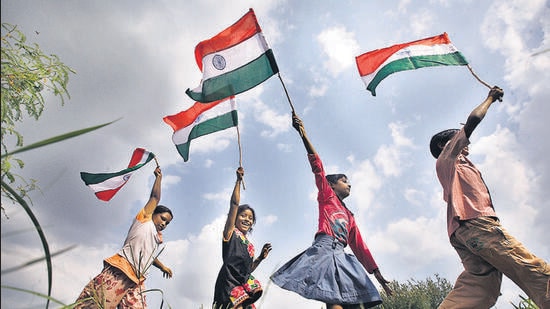HTLS 2022: Crafting a model of governance to better serve future generations
Hindustan Times Leadership Summit 2022: In many contexts, India has interpreted tomorrow as Amrit Kaal, the template and aspirational goal for India in 2047, 100 years after Independence.
Tomorrow is another day, 24 hours from today. Barring catastrophic events, natural or man-made, nothing dramatically changes within a short time. But tomorrow is a metaphor for what the future augurs. In some languages, the word for tomorrow is no different from the word for yesterday, underlining that the future flows from the past, via the present. Predicting the future is always fraught with uncertainty. While there is always uncertainty, that uncertainty perception has been compounded by the pandemic, current geopolitical tensions and retreat from globalisation (both trade and financial). In many contexts, India has interpreted tomorrow as Amrit Kaal, the template and aspirational goal for India in 2047, 100 years after Independence.

Twenty-five years is a short period in a nation’s evolution, but it is long if one considers disruptions caused by technology. What will happen 25 years from now, in 2047? Specifics are impossible to predict. Any prognosis undertaken in 1997, 25 years ago, was often wrong. However, some trends are discernible and are insulated from uncertainty, especially of the transient kind. Covid-19 passed, and so will the Russia-Ukraine conflict. Often, the human mind gets bogged down in the immediate and misses the big picture.
First, there is the inexorable phenomenon of real economic growth in India. One can quibble about whether it will be 6% or 8% in the medium term. But beyond the transient, there won’t be much quibbling about the band. The exponential power of growth is often not appreciated enough. When Goldman Sachs published the widely quoted BRICS (Brazil, Russia, India, China and South Africa) paper in 2003, assumed real growth for India was an average of around 5.5%. Today, aspirations have changed so much that a 5.5% growth will be regarded as below par.
Second, depending on assumptions made about exchange rates, that kind of growth means a per capita income of $10,000 in 2047 and aggregate size of the economy of almost $20 trillion. India will move into the upper-middle income and high human development category. Such an aggregate size of the economy increases India’s global clout and influence in global institutions.
Third, these aren’t mere numbers. As a recent United Nations Development Programme report points out, extrapolating from the past, this implies a decline in poverty and a change in the nature of poverty. Growth, provision of basic necessities and targeted subsidies ensure that.
There are several transitions that go along with that - a more urbanised and formal India, a switch from subsistence-level self-employment to wage employment, a shift from conventional food-grain-driven agriculture, a greying India, a more digital India and an India where mobility/migration and portability of services become easier. These are socioeconomic transitions collapsed within the space of a couple of generations, unlike the decades that more developed countries had to handle them. To name but one, how do we handle social security when a country ages before it develops? Alternatively, within the job market, as emphasis shifts to contractual and part-time work, in apparent contradiction of the point about formalisation, what does social security mean?
There are broader issues of governance that arise. What should the government be spending on? What level of government (Union, state, local body) should be spending it? How does the government generate resources, tax and non-tax? In other words, there is an implicit discussion and debate about the role of government. Citizens have become more demanding about better delivery of public goods and services, legitimately asking for transparency and accountability, and, as India develops and urbanises, these trends will become stronger, not weaker. This means, as a polity, we have to reinvent government and find resources for governance and administration.
Resources don’t mean financial resources alone. They also mean human resources, and in any reform discussion, the lower rung of civil services rarely finds a mention. Nor does the government mean the executive arm alone. The legislature and judiciary also form a part of government. These questions figure implicitly, so far. There are cross-country studies, establishing a link between economic development and better governance, though it is difficult to define, measure and quantify governance. A link means correlation, not necessarily causation. While better governance may lead to higher levels of economic development, higher levels of economic development also trigger better governance.
As India moves up the development ladder tomorrow, this questioning of institutions of governance is inevitable and will become explicit. We can already see the trends in media, particularly social media. Stated a bit differently, institutions of governance have been set up through the Constitution, and in 75 years, the Constitution, based largely on the Government of India Act of 1935, has served us well. But I think a question will be asked about whether a different Constitution will serve the interests of tomorrow’s India better.
Rajani Palme Dutt was a communist who is probably hardly read today. He wrote two books, India Today in 1940 and India Today and Tomorrow in 1955, the latter a revised and enlarged version of the former. They naturally reflected his views. I mention them only to illustrate a simple point. The burning issues of today are not the burning issues of tomorrow. Time and technology provide disruptions and alter lives in ways we don’t know. What we do know is that India’s economic prospects are bright, reinforced by a young, dynamic and entrepreneurial population impatient for change. As a former United States president famously remarked, the torch has passed to a new generation of Indians, the India of tomorrow.
Bibek Debroy is chairman of the Economic Advisory Council to the Prime Minister of India. The views expressed are personal.






